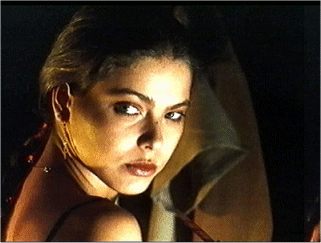Dig Kim Morgan’s terrific interview with George Segal, Elliot Gould and Joseph Walsh.
Million Dollar Movie
Because you can’t ever get enough of a good thing here’s more–from the beautiful site, Cinephilia and Beyond–on The Long Goodbye:
I decided that we were going to call him Rip Van Marlowe, as if he’d been asleep for twenty years, had woken up and was wandering through this landscape of the early 1970s, but trying to invoke the morals of a previous era. I put him in that dark suit, white shirt and tie, while everyone else was smelling incense and smoking pot and going topless; everything was health food and exercise and cool. So we just satirized that whole time. And that’s why that line of Elliott’s—‘It’s OK with me’—became his key line throughout the film. —Robert Altman
Million Dollar Movie
Bob Balaban: Altman-esque means never having to say you’re sorry. Bob did what he wanted in the face of tremendous obstacles and he really was programmed that way. I suspect as a child he was pretty stubborn all his life. What was he like as a child Kathryn, did you ever hear stories about him?
Kathryn Altman: Yeah, I can’t believe them!
BB: But to me, the whole key to Robert in everything, was that he was someone who followed his own beat and listened to his own drum. You couldn’t dissuade him from that path, and that was one of his great strengths as a filmmaker, and possibly as a human being as well. So that’s Altman-esque to me.
KA: Right off the top of my head, my synonym for Altman is having the world’s greatest sense of humor—I mean, just the world’s greatest, the best. And that’s something that shows in all his pictures in so many different ways and always comes up at some point.
BB: One of the greatest secrets of writing and directing is that people with senses of a humor really understand that there’s no difference between comedy and tragedy, it’s all mixed in there together just as in life. And most filmmakers say, this is going to be a funny movie or this is going to be a serious movie, but for Robert, I don’t think there was any dividing line between. It was life, it wasn’t serious, it wasn’t funny, it was life.
Million Dollar Movie
More on Short Cuts. Dig this excellent documentary.
Million Dollar Movie
From Will Harris’ Q&A with Elliot Gould over at the A.V. Club:
The Long Goodbye (1973)—“Philip Marlowe”
EG: As I was growing up, I would go to see film-noir films, the detective stories, and I thought Humphrey Bogart was the greatest. David Picker, who was running United Artists at the time, gave me Leigh Brackett’s script adapting Raymond Chandler’s The Long Goodbye and asked me to read it, so I read it. I was looking for a job at the time and… let’s say that finding a job wasn’t easy at that time, though I don’t know if it’s ever easy. There was another director who was going to be doing it, but he couldn’t see me in it. Then David Picker gave the material to Robert Altman, and Altman called me from Ireland, where he was finishing Images with Susannah York. Bob said to me, “What do you think?” I said, “I’ve always wanted to play that guy,” meaning Philip Marlowe. And Robert Altman said to me, “You are that guy.” So that was the beginning of that.
AVC: There’s been talk for some time of you teaming with Alan Rudolph to produce a sequel to The Long Goodbye.
EG: Yeah, I started to work on a sequel. I think I’ve basically read or narrated the books on tape of all of Raymond Chandler’s work, and I discovered “The Curtain,” which was written before there was a Philip Marlowe. The Chandler estate worked with me when I was more involved in it, although I’ll never give up on it. For as long as I can, I’ll try to work on getting a sequel to The Long Goodbye. I had a treatment developed and gave it to Bob Altman, and we started to talk about it, but then Bob passed away. But Alan Rudolph was the second assistant on The Long Goodbye, and Alan wrote quite an excellent first draft. But I haven’t been able to finance it.
The estate had given me permission at the time—this was just a few years ago—to change the name of the character, because the private eye was called Ted Carmady. It was written by Chandler before he wrote The Big Sleep, but you could see where The Big Sleep came from. In the story, there’s a 10-year-old son of the character that Bacall played in The Big Sleep, and the son is the killer. That’s what attracted me to it. It would take place now, and the character of Philip Marlowe is now a much older man, like me, but he still has the same values. It’s something that could conceivably work if it’s free to express itself the way I feel it and see it, but whether it’ll ever happen remains to be seen. But I’m just eternally grateful for Robert Altman and David Picker giving me the opportunity to participate in The Long Goodbye and play Philip Marlowe.
Million Dollar Movie
Over at the Los Angeles Review of Books, dig this piece on Pauline Kael by Ricard Kramer:
Pauline Kael herself opened the door to her apartment and it was the first of many doors she would open for me, over many years. Standing there in the hallway, I had yet to reach my full height, but she still had to look up to see me. I was amazed. She was tiny? How could that be? She was huge on the page, an empress!
“Oh shit,” she said. “You’re just a baby. Come on in.”
She laughed. The first time I would hear that laugh — musical, rangy, a broad’s laugh, a laugh that welcomed you even as it warned you that once you stepped through that door, you were expected to join her in her merry fuck-you to all bullshit, bluster, and begging-for-Oscars “worthiness.”
I followed her through her rooms. They were white, and the floors looked like someone had polished them with honey. The ceilings were high, and in every room books climbed from the floorboards all the way to the top. She led me to a table, and as she got me a soda, a large man emerged from the bathroom, tucking in his shirt. He nodded to me, didn’t offer a hand.
“Oh, fuck you, Bob,” she said. “You can shake hands with him. He’s not going to take a job from you.” “Bob” obeyed. “This man,” she told me then, “is our Next Great American Director, honey. And so far, I’m the only one who knows it. But that’ll change.” Next Great, etc. (yes, Robert Altman) left us and she told me about the movie he’d just finished, a comedy about the Korean War that was so good and so fresh the studio was talking about not releasing it — that before I arrived, he had been in tears.
“Peckinpah is a crybaby, too,” she said. “The tough guys always are. I don’t know about John Ford, but I’m not sure I want to know about John Ford.” (Thirty-five years later I sat across the aisle from Altman on a plane. He slept the whole way, so it wasn’t until we were both at baggage claim that I got up the nerve to introduce myself and share the scene of that long-ago afternoon. He thought for a moment, mumbled something, and then, adjusting his expensive suede cowboy hat, said, “Pauline Kael … Pauline Kael … Oh. Right. That’s the cunt who destroyed me.” And that is why one should never approach one’s idols at baggage claim. I’m convinced that Pauline would have laughed at that, though. She did love her bad boys.)
Million Dollar Movie
Over at Narrative, dig David Thomson on The Long Goodbye:
Robert Altman was more persistent, and difficult, but he was never quite a movie brat, even if M.A.S.H., the biggest hit he would ever enjoy, is a 1970 film. Altman was from Kansas City (born in 1925). He fought in the Pacific War and had a long training in the Midwest making industrial films before moving into television. He was in his forties by the time he got to M.A.S.H., fourteen years older than Bogdanovich, and never a clubbable man. But Altman had a similar urge to address the old Hawksian models. That drew him to The Long Goodbye (1973), a new version of Raymond Chandler’s world (scripted by Leigh Brackett, who had worked on the original The Big Sleep in 1946).
But this was now the Los Angeles of the early 1970s, filmed in wide screen with an easygoing zoom photography by Vilmos Zsigmond, and a total reappraisal of Chandler’s Philip Marlowe. The knowingness and the biting wit of Bogart’s private eye was replaced by Elliott Gould, untidy, hapless, perhaps a little druggy, a sucker most of the time, talking to himself, and a man who has a neurotic cat but no girl. Hawks’s fantasy had been immaculate and irresistible, but Altman saw Marlowe as a dreamy loser, falling behind the money race of L , inclined to trust the wrong people, but ever amiable. His single comfort in the film is the fond, mocking way the song “The Long Goodbye” (written by John Williams, lyrics by Johnny Mercer) is the only score to the picture, a refrain that keeps coming back in so many different styles and versions.
But The Long Goodbye opens and closes with the old standard “Hooray for Hollywood,” and it concludes with a gesture toward the unyielding conclusion to The Third Man. So Altman knew his history but he distrusted it and felt sick over the white lies of the factory system. In a sour Altman touch, Sterling Hayden plays the alcoholic writer who has given up the ghost, trading on our knowledge of Hayden’s own remorse over having been a friendly witness for HUAC. No one ever accused Altman of being a gentle fellow. He had a mean streak. But its offsetting benefit was the mistrust, solitude, and breakdown in his films, and it went with a helpless sympathy in the way he looked at the oddity of people. This was Altman’s third coup in three years. For in 1971 he had redrafted the Western as a melancholy love story about a fool who cannot impose his story on the world but who ends up with an epic triumph that no one notices in the falling snow and the lamenting songs of Leonard Cohen. McCabe and Mrs. Miller (1971) had Warren Beatty as John Q. McCabe, in a beard and derby hat, a brothel-keeper of sorts in the Northwest, taken over and smitten by Mrs. Miller (Julie Christie), but such a chump at handling the local syndicate that he signs his own death warrant. (It’s another film about the defeat of the individual.)
As photographed by Zsigmond, McCabe and The Long Goodbye proposed a new way of seeing. For decades Hollywood had constructed and composed its images as framed things: they were the brickwork of stability. But Altman and Zsigmond substituted a slippery wide-screen vista where the slow zooms oozed in and out, and we were left as searching eyes. “What should I look at? What is there to see and what is hidden?” Altman often seems to film in what Gavin Lambert, referring to a part of Los Angeles, once called the “slide area.”
That was as radical a stylistic departure as Godard’s jump-cutting, for it argues that the screen’s threshold is a place for searching, instead of somewhere we receive decisive, chosen sights. The imagery relinquishes its old assurance, but we are drawn deeper into the maze and the illusion. And the melancholy in both these pictures is part of a forlorn inquiry, wistful over the old, vanished indicators. Altman went further still. Where once sound had been skillfully miked and the final soundtrack mixed, cleaned, and clarified, for sense and meaning, these two films leave us asking ourselves, “What did he say? Did you quite hear that?” The spatial confusion was aural too, and the players were miked separately, often with the new radio mikes, and a mix was then made that brought voices in or out and was seldom clean and not always audible. This may seem perverse, but a movie where looking and hearing are muddled or compromised may get closer to our uncertain experience of life than the emphatic precision of the golden age, when a shot or a frame did not pass without being completely informative and “correct.” “Was that take ‘okay’? If not, take it again.”
Another facet to his style was Altman’s developing interest in groups—and that was another novelty in American film, where the hierarchy of stars, supports, bit parts, and extras had been set in stone. Altman was always close to scorning or bypassing stars—he and Beatty got on badly because of this—and he loved crowded shots and group scenes. The first destination for that approach would be Nashville (1975), a whimsical portrait of the real place, with twenty-six roles of more or less the same size. Further down the road, Short Cuts (1993), derived from stories by Raymond Carver, was a panorama of Los Angeles in which the pattern of overlapping events conveys a very fresh sensibility for real turmoil held in place, or kept calm, by the principle that no single story, person, or self-centered universe really matters enough to be the center of attention. That’s one explanation for how Altman was making the most innovative American films in the moment of The Godfather. By reputation, Coppola’s picture is violent. But Brando’s Vito Corleone is as adorable as he is magnificent. Think of Joe Pesci in Casino (1995), and you realize how much hideous pathology is left out of Vito. He has a kitten in his lap in that opening scene; the enchantment goes all the way to the moment he is playing with a grandson in the garden and has his heart attack. He is gracious, kind, and sad.
Excerpted from Thomson’s new book, The Big Screen: The Story of the Movies.
Million Dollar Movie
If you’ve never seen “The Late Show,” well, you should.
It’s not a great movie but it’s more than solid–plus it looks great–and there are worse things you can do than watch Art Carney and Lily Tomlin.
Here’s Roger Ebert’s review. The movie was directed by Robert Benton and produced by Robert Altman. Come to think of it, “The Late Show” would make a sweet double feature paired with “The Long Goodbye.”
Bronx Banter Interview: Sanford Schwartz
“The Age of Movies: Selected Writings of Pauline Kael,” edited by Sanford Schwartz is a new release from the Library of America and it’s been getting a lot of press along with Brian Kellow’s Kael biography. I’m going to blog about P. Kael, who is one of my favorite writers, all week and will include all the links fit to click.
For starters, here’s a recent conversation I had with Sanford Schwartz.
Check it out:
Bronx Banter: What was your approach in selecting the material for this book? My first impression was that it seemed thin, but then I checked and it is almost 800 pages, anything but thin. Then again, I grew up reading Kael and have all of her books. Is the ideal reader for this book someone who is unfamiliar with her work?
Sanford Schwartz: My first aim in selecting Pauline Kael pieces was to give the range of her thinking and sensibility. As a kid of shadow story, I wanted the selections to give a rough sense of movie history during the years she wrote. I wanted there to be representative pieces on the actors and directors who meant most to her. So there are a number of reviews on Altman, Godard, Scorsese, and so forth. I hoped that the anthology would engage people who already knew her—but unlike you didn’t collect all her books over the years—and also people who, in their twenties and thirties, don’t know who she is. It is always a surprise to run into people who have never heard of her, and I have found that most young people haven’t.
BB. Kael was close to fifty when she started reviewing movies for the New Yorker though she’d been writing for some time. How do you think this influenced her voice as a writer, as opposed to other critics who get their start much earlier?
SS: I’m not sure that it meant a lot. Her having waited so long and absorbed so many movies along the way obviously couldn’t have hurt when it came to writing with authority and conviction. But that certainty was evident in her letters from the late 1930s and early 1940s, when she was in her early twenties—except that her subject was still unclear to her. And it was fortuitous, her coming into the field when she did—an art form was being revitalized.
BB: What did Kael bring to movie criticism in the 1960s and ’70s that set her apart from her contemporaries?
SS: Kael made reading movie reviews a more intimate and personal experience than it had ever been before. Little criticism of any kind conveyed a comparable sense of there being such a powerful, funny, opinionated, scarily shrewd, and common sensical voice there, talking to you. You wanted to know what she thought about everything. You don’t feel this with most journalists, whether they are reviewing an art of doing a political column.
BB: One of the quirks that Kael was famous for was only watching a movie once. She’s been criticized for that over the years, that it suggests a lack of reflection or the possibility that a work of art can change for you. What is it about watching a movie only one time that informed the way she wrote about it?
SS: First off, it should be noted that there were times when she saw a movie more than once. I saw a number of movies with her when it was her second time. But then it was usually because she was checking something. I think she joked about falling asleep during Bresson’s “Diary of a Country Priest” both times she saw it. How many times she saw a movie was conditioned, actually, by her generally tight writing schedule; she usually didn’t have the time to see a movie twice. But the deeper point with this issue concerns the importance of instinct for her. She believed our truest response to a movie (or any art) was our first one, and she wanted to catch that. It was also a matter of temperament. She had on-the-spot judgments about many things. That was how she operated. Movies for her, even the great, complex ones, were about the senses in a way that books were not, and in seeing a movie once and trying to recapture its immediate impact she was, in her thinking, being true to the experience it offered.
BB. Did you re-watch any of the movies whose reviews you included in the collection?
SS: I saw some again, and initially I thought it would be good to re-see many of them. But my sense if that going back to films I loved years ago is hazardous. You re-see Truffaut, Satyajit Ray, or “The Leopard” and part of you must confront ways that the movie, and you, have changed—and altogether the event is more about time than the movie. How movies age is an interesting topic. Kael talked about it in “Movies and Television.”
BB: You’ve included her most famous reviews, ones she was chided about for over-praising like “The Last Tango in Paris,” “Nashville,” and to a lesser extent, “Casualties of War.” How do you think her takes on those movies stand up?
SS: I can’t say how her reviews of those movies hold up because I haven’t seen them recently. My hunch is that she did go overboard on them. I probably felt that then. But of course the reviews had to be in any anthology of her work. They were major pieces for her. They are statements of her belief.
BB: Kael has been ridiculed for her enthusiasm for those movies, but her take on other “classics” of that time period, particularly two “Godfather” movies or “Mean Streets” or “Shampoo” seem spot on. Are there any particular movies that she loved where you feel that her writing is especially sharp?
SS: I wasn’t that interested in whether she was, as you say about some of her reviews, “spot on.” In reviewing an art, reasoning and descriptions count for much more than opinion. As to what I think she was especially sharp on, I hope “The Age of Movies” provides an answer. Are there many more pieces that might have gone in? For sure.
BB: I like that you’ve included her major essays like “Trash, Art and the Movies,” “Why Are Movies So Bad? or The Numbers,” and the long one on Cary Grant, “The Man From Dream City.” And especially an early on, “Movies, the Desperate Art.” But you did not include her celebrated essay on “Citizen Kane.” Is that because it was just too long or because you feel it doesn’t hold up as representative of her talent?
SS: No, the Kane article, as I say in the Introduction, is too long to be included.
BB: One of Kael’s first memorable articles was “Circles and Squares,” a harsh take on fellow critic Andrew Sarris’ ideas about the auteur theory. Why did you not include that one?
SS: I didn’t include the Sarris essay because it is too long for the points it makes. It would have hogged space from livelier writing—writing that meant more to Kael. There are good words in it on what criticism meant for her. If I had excerpts in the anthology I probably would have excerpted those passages. I felt also that readers for whom “auteur” issues mater would already know Kael’s piece, whereas for the wider audience that she wrote for at The New Yorker, and for whom “The Age of Movies” is intended, her deflating this theory—it is really a set of opinions—is not a very engaging issue. And while I think she nails Sarris and the whole approach, she doesn’t do it in a way that opens up the topic to the general reader. Unless you are already familiar with the auteur line, her essay is rather confusing, especially at the beginning. It isn’t an essay that had much long-term meaning for her; she never could take that stuff seriously.
BB: Kael’s review of the documentary, “Shoah,” was famous because she panned it but it’s not here.
SS: I didn’t have a powerful reason to skip the “Shoah” review. Probably, it was a matter of space and also the sense that the reasoning and attitude on display there was already clear from other articles. It is certainly a strong one, though.
BB: During the ’70s, Kael shared her position writing “The Current Cinema” at the New Yorker with Penelope Gilliatt. As a result, there are some classics from that time that she never reviewed properly like “Annie Hall,” “Dog Day Afternoon” (though she does mention this one in a notes column), and maybe especially, “Apocalypse Now.” Were there any movies that you missed her reviewing?
SS: Even with her half-year schedule in the beginning, I believe she managed to encompass the major films of her era (but a movie historian might have another view of this). If a movie was taken seriously or touched hot issues for people—and it came out when she was off—she generally managed to find a way to her her verdict in somewhere. The long articles she periodically wrote during the time she was off let her do just that. She used a piece ostensibly about actors to acknowledge “Jaws” and she let people know where she stood on “2001” in “Trash, Art, and the Movies.”
BB: Kael had her favorites—Peckinpah and DePalma, to name just two—and those who she was famous for blasting, like Kubrick and Woody Allen. But she actually took each movie as it came, and I like that you’ve included “Lolita,” which she adored and as well as “A Clockwork Orange,” which she hated. Same goes for the early Scorsese hits, “Mean Streets,” and “Taxi Driver,” again, which she loved, and “Raging Bull,” which was the first in a long line of his movies that turned her off. Even though she was famous for her prejudices do you feel that she always gave a new movie an equal chance?
SS: Oh, yes. That is one reason I included her review of Bergman’s “Shame.” The piece shows her wrestling with the fact that a director with whom she was often at odds made a movie she had to call a masterpiece. She could always say when someone she admired—Altman, Godard, Bertolucci, Huston, even Renoir—came out flat. Her subject was the film at hand, not someone’s reputation or the credit they might have built up. She didn’t much like Robert Duvall, but after she saw “The Apostle,” which he directed and wrote as well as starred in, she said something like, “You’ve got to hand it to the bastard.”
BB: Kael once said that she never wrote a memoir because, “I think I have” in her reviews. She brought her life’s experience to her reviews, from what she knew about music and books and the theater, but also from what she knew about being a mother, having her heart broken in relationships, everything. Do you think you the story of her life can be found in her work?
SS: Yes, if the story of her life is constituted by her awareness and judgments. I don’t think she was the kind of artist whose life experience mirror or can be seen as a counterpoint to their work. For Agee and Farber, yes; their movie reviews tell us things about each man’s total contribution that we might not know otherwise. Kael, though, put most of what counted in her life in her reviews.
BB: She also once said “In movies, judgment is often not so important in a critic as responsiveness to what a movie feels like, and where it’s heading and what its vision is.” She was very tuned in to the reaction movies had on audiences, especially during her heyday in the early ’70s. Was there any other critic during that time, or any other time, that was as invested in how movies were received by popular culture and what it all meant?
SS: I believe you need a movie historian to answer this one. My feeling is that she got more of the ramifications of movies—their relation to the wider culture and society in general—than most film writers.
BB: This collection is spare toward the last 10 years of her career. Is that because the cultural moment of the movies had passed by the mid ’80s or because you were running out of room? Even though the pieces in her final two collections, “Hooked,” and particularly, “Movie Love,” are terse compared with her earlier writing, I think they had a lovely, compact quality. Were there any reviews that were hard for you not to include?
SS: Kael herself said that her strongest collections were those that covered the films of the 1970s. The movies were richer then. They brought out more of her. And she was first luxuriating in all the space The New Yorker gave her. It is possible that if she had first started reviewing in 1980 her pieces might have been longer and more nuances—even considering the quality of the movies. As it was, by the mid-1980s she had already put forth in some detail her aesthetic and social positions. I agree with you, though, about the “lovely, compact quality” of her reviews of the eighties.
BB: I recall Kael once writing with admiration for the discipline it took Altman to achieve a style that appeared casual and loose. I often think about that when I consider her writing—it is conversational but don’t you think it must have taken a lot of discipline to achieve that effect?
SS: Kael was almost always writing with a deadline, so the words had to come fast, and by nature she was suited to spilling her feelings. But she had to do a lot of work to get the reviews in shape. She could be making substantive changes right to the last minute.
“The Age of Movies” is out now and you can order it here.
As a follow-up to my conversation with Schwartz, I dipped into my library for more Kael and found this in “Afterglow: A Last Conversation with Pauline Kael,” by Francis Davis:
Well, the auteur theory originally meant something quite different from what people understand it be mean now. What it originally said was that a director conferred value upon a film—that if a director was an auteur, all of his films were great. I think the public never understood that, and neither did most of the press. It was an untenable theory, and it fell from sight. It’s now taken to mean that we should pay attention to who directed a movie, because a director is vital to a film, and of course this is true. But it’s something that everybody has always known. I mean, everybody knew that Howard Hawks was terrific. We went to see “To Have and Have Not” and “The Big Sleep” the day they opened, and there was an excitement in the theater, because we all knew that these movies were special. They were smart, and we loved the work of smart directors, because lots of movies were so dumb…But the auteurists considered all of his movies to be wonderful by definition, because he was an auteur. It reached a point where they were acclaiming the later movies of directors who had ceased doing good work years earlier. Hitchcock’s later movies were acclaimed, and they were stinkers—terrible movies. And many routine action movies were praised because they were the work of certain directors.
It’s sometimes discouraging to see of a director’s movies, because there’s so much repetition. The auteurists took this to be a sign of a director’s artistry, that you could recognize his movies. But for all of a director’s movies to be alike in some essential way can also be a sign that he’s a hack.
And this on Andrew Sarris:
We both loved movies. We had that in common, and I enjoy reading him as I enjoy reading very few critics. He has genuine reactions to movies, and many critics don’t. He picks things up and points things out…The big difference between us is that our taste in movies is so radically different. He really likes romantic, classically structured movies. He had very conservative tastes in movies; he didn’t love the farout stuff that I loved. He’s a man who likes movies like “Waterloo Bridge,” movies that drive me crazy with impatience. It’s funny that he should have been at the Voice, and the voice of an underground paper. I think I would have been much more suitable to the Voice, yet for years I got dumped on brutally by the paper. That always amazed me, because I thought, I’m praising movies you should love, so what’s going on here? He and I were at the wrong places—it’s one of those flukes of movie history.
Also this on eroticism in movies and not being able to review “Deep Throat” for the New Yorker:
It wasn’t a good movie. But I very badly wanted to write about it, because for all that was being written about it, nobody was really dealing with what was on the screen. I think half of the reason that people become interested in movies in the first place is sex and dating and everything connected with eroticism on the screen. And I felt that not to deal with all of that in its most naked form was to shirk part of what’s involved in being a movie critic.
I’d love to have written about more eroticism in the movies. I think it’s a great subject, and I dealt with it a little bit in my reviews of “Last Tango in Paris,” “Get Out Your Handkerchiefs,” and a few other movies. Bertrand Blier I loved writing about, because he dealt so much in sexual areas. But it was tough to write about it all with [New Yorker editor, William] Shawn. I had a real tough time with him when I wrote about “Tales of Ordinary Madness,” The Marco Ferreri version of Charles Bukowski, about a girl who’s virtually a mermaid, with Ben Gazzara as the Bukowski, more or less. It’s an amazing movie, with some scenes that are quite erotic. I had to put up a terrible fight to get it in. Shawn wanted to know if the critics for other magazines were covering it. I said that shouldn’t be our standard for what we covered at The New Yorker. But it was hard to convince Shawn that I wasn’t pulling some sort of swindle by sneaking material into the magazine that he felt didn’t belong there. He felt he was holding the line against barbarians, and to some degree I was a barbarian.
He made it very hard to write about certain aspects of movies. Nobody, really, has done a very good job of writing on a sustained level about the way movies affect people erotically, and about the fact that they became popular because they’re a dating game. People love movies that reason, because they excite them sexually. They go to them on dates, and they go to learn more about how to behave. I never got a real crack at writing about that.
Another terrific volume for Kael nerds is “Conversations with Pauline Kael”.
From an interview with Sam Staggs in Mandate (May 1983):
Mandate: Why do you hit so many nerves among the common readers? Why do you stir up such antagonism as well as such passionate devotion?
Kael: In my writing, I was trying to get at what I actually responded to at the movies, and I couldn’t do in formal, scholarly language. I worked to loosen my style—to get away from the term-paper pomposity that we learn at college. I wanted the sentences to breathe, to have the sound of a human voice. I began, for example, to interject remarks—interrupting a train of thought, just as we do when we talk, and then picking it up again. And when I began to feel the freedom to write as easily as I spoke, the writing itself became pleasurable.
Maybe part of the resentment I stir up among critics who suffer when they write is that they can tell I’m having a good time. My guess is that just as my slangy colloquial style appeals to some readers because it is sometimes enables me to get right at what I think the emotional substance of a movie is, it turns off other readers, who prefer more literary, distanced criticism. For example, I’m frequently disparaged as ‘opinionated’—I think what this comes down to is that often I don’t share in the consensus that builds up on certain movies. Sometimes, it builds up even before the critics have seen a picture, as it did on “Sophie’s Choice”—I suspect that a lot of readers are snowed by big themes and advance articles in the New York Times. And then, if they read me making fun of the picture, they’re outraged and think I’m irresponsible, and especially so because I don’t couch my review in the language that has come to be equated with ‘objectivity.’
And from a Q&A by Marc Smirnoff in the Oxford American (Spring 1992) after Kael had retired from the New Yorker:
Q: Is a person lucky to be a movie critic?
Kael: It is really a wonderfully exciting field to write about when the movies are good. When they’re not good, it’s to despair. The really bad movies you can write about with some passion and anger. It’s the mediocre ones that wear you down. They’re disgusting to write about because you can feel yourself slipping into the same mediocrity and stupidity. And you feel you’re boring the readers and yourself. When you starting falling asleep while you’re writing a review, you know how dull the movie is. The danger for criticism is that people will want to become critics in order to become television celebrities, rather than enjoying the pleasure of writing and the excitement of trying to define and describe what you’ve seen.
Q: Do you miss writing reviews?
Kael: Yes, but I know I’ve got to adjust to it. That’s part of adapting to getting older. You’ve got to recognize that the time for certain things has passed and, I’m not an idiot, I know I would not write at my best if I went on. You know, you start repeating yourself—you write the same phrase, you write the same descriptions. I’ve already had the problem of working on a paragraph that I thought was pretty good and looking up what I said about that director’s work the last time I wrote about him and finding out it was almost exactly the same paragraph. Well, you know, it’s time to quit.
Million Dollar Movie
Here’s a long, thoughtful, and engaging essay about “Nashville” by Ray Sawhill (Salon, June 27, 2000):
With the release of “Nashville” and “Jaws,” the summer of ’75 delivered both the culmination — and the beginning of the end — of that period. “Nashville” seemed to incarnate a film buff’s hopes for American movies. Here was an artist putting the machinery of popular culture to work for the sake of art, yet entering into the spirit of popular culture and partaking of its energy too. That was the dream: the power of popular art combined with the complexity of fine art, high and low not at war, and not blurred indistinguishably into each other, but embracing.
“Nashville” was debated in the mainstream press in a way that seems inconceivable now: The New York Times ran at least eight pieces about the movie, and editorial writers and critics weighed in with opinions and interpretations for months after the film opened. (The movie’s 25th anniversary isn’t going unnoted. The Times and Premiere have already run major pieces about Altman; Fox Television will broadcast a documentary about him, “Altman: On His Own Terms,” on August 13; the Academy of Motion Picture Arts and Sciences screened the film on June 22 in Los Angeles, with Altman and various cast and crew members in attendance; and, in November, Simon & Schuster will publish “The ‘Nashville’ Chronicles,” by the Newsday film critic Jan Stuart. Paramount will release the DVD version, offering its proper Panavision screen-aspect ratio, on August 15.)
But it was “Jaws” that captured the mass audience and really changed movies. It wasn’t the first big success of the boomer generation, but it was a hit on a scale no one had ever seen before. (Within a month of its release, the stock of MCI, the conglomerate that owned the film company that released “Jaws,” went up 22 points.) The aftereffects of “Jaws” rattled the world of film from top to bottom: Soon the artists were coming a cropper — Altman spent the rest of the decade creating ever-more-perverse head-scratchers; Coppola spent years on the debilitating “Apocalypse Now,” and seems never to have recovered his energy or concentration; Scorsese tripped himself up making the over-ambitious, epic musical, “New York, New York.” In 1977, George Lucas’ “Star Wars” was released, and the intellectual and art side of filmmaking and filmgoing has been scattered to the four winds ever since. Despite the occasional good movie, the news since has all been about technology, effects, gender, race and business.
Sawhill concludes:
In 1975, film was potentially the greatest of all the arts; in 2000, it’s one data stream among many. The hierarchical, centralized culture the baby boomers reacted against could be exclusionary, and its emphasis on ego and on greatness could be annoying. But it offered the possibility of something called “depth,” and it also provided a shared culture and language. The atomized, decentered culture we have now allows for horizontal ranging about; the new digital tools (and media) are irresistible; and the openness to cultural mixing is certainly a relief. But this mix-and-match culture can also seem shallow. If everything’s always available, why bother trying to unearth anything? (If it isn’t on a database, it doesn’t exist.)
A young Ivy League graduate I know made a success in arts journalism without ever having seen a Bergman picture. When she finally caught up with one, she was stunned to realize that there’d once been a time when people went to a movie theater to watch characters agonize and philosophize at each other. She hasn’t seen another Bergman since, and she hasn’t gone on to read any Scandinavian literature, or to search out further examples of Swedish films either. In Altman’s “The Player,” a comedy about what has become of Hollywood, a young studio executive is watching his career dissolve, and recovers his momentum only when he learns to stop worrying about integrity and depth. During my lunch with him, Altman observed wryly that one thing he could say for the executives he’d battled in the ’70s was that they cared enough about the work being done to get angry at you, and to hate your movies. Nowadays, when someone takes an idea upstairs for a decision, there’s nothing there but a computer.
Watched on videotape today, “Nashville” seems in its element in a way many movies don’t. It’s alive, and it doesn’t suffer from the fragmenting effects of stop-and-start, at-home viewing. This may be because Altman is instinctively drawn to multiple points of view and unresolved resolutions. It doesn’t exactly cohere, but it seems to bring our channel-surfing minds and experiences into some kind of loose relationship. It gives the impression of being a video installation rather than a routine feature; you can get the feeling that it’s playing on several monitors at once. Watching it made me think that one way of conceiving of TV is as movies gone to pieces and turned into wallpaper.
It also made me think that an upbeat way of looking at where we’ve arrived is this: We have been freed — perhaps against our will — of our attachment to the idea of art as a rebel activity, a gesture toward freedom made for the sake of the unconscious and revolution. Now it has become simply an activity some people pursue, and perhaps get something out of — as legitimate as (but no more vanguard than) business, cleaning, sports, science and child-rearing. “Nashville,” seen at this distance, looks like a snapshot of the moment when substance began to vaporize into information.
Friday Night Flix
Some You Tube fun on a cold winter night:
My favorite Scorsese flix (his ma makes the sauce):
Love this movie:
Bouton as Terry Lennox…
Mr. Barbar.
--Earl Weaver




































